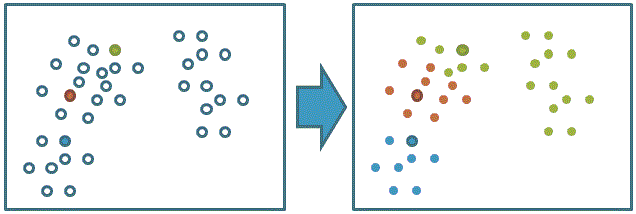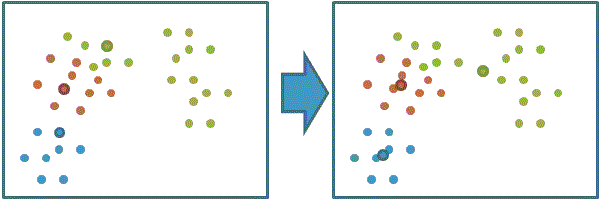最近在苦於思考kmeans演算法的MPI並行化,花了兩天的時間先把串列版本實現了。 聚類問題就是給定一個元素集合V,其中每個元素具有d個可觀察屬性,使用某種演算法將V劃分成k個子集,要求每個子集內部的元素之間相異度儘可能低,而不同子集的元素相異度儘可能高。 下麵是google到該演算法的一個流程圖,表意清 ...
最近在苦於思考kmeans演算法的MPI並行化,花了兩天的時間先把串列版本實現了。
聚類問題就是給定一個元素集合V,其中每個元素具有d個可觀察屬性,使用某種演算法將V劃分成k個子集,要求每個子集內部的元素之間相異度儘可能低,而不同子集的元素相異度儘可能高。
下麵是google到該演算法的一個流程圖,表意清楚:
1、隨機選取數據集中的k個數據點作為初始的聚類中心:

2、計算每個數據點對應的最短距離的聚類中心::

3、利用目前得到的聚類重新計算中心點:

4、重覆步驟2和3直到收斂(達到最大迭代次數或聚類中心移動距離極小):
code:
1 #include <stdio.h> 3 #include <stdlib.h> 4 #include <math.h> 5 #include <time.h> 6 7 int K,N,D; //聚類的數目,數據量,數據的維數 8 float **data; //存放數據 9 int *in_cluster; //標記每個點屬於哪個聚類 10 float **cluster_center; //存放每個聚類的中心點 11 12 float **array(int m,int n); 13 void freearray(float **p); 14 float **loadData(int *k,int *d,int *n); 15 float getDistance(float avector[],float bvector[],int n); 16 void cluster(); 17 float getDifference(); 18 void getCenter(int in_cluster[N]); 19 20 int main() 21 { 22 int i,j,count=0; 23 float temp1,temp2; 24 data=loadData(&K,&D,&N); 25 printf("Data sets:\n"); 26 for(i=0;i<N;i++) 27 for(j=0;j<D;j++){ 28 printf("%-8.2f",data[i][j]); 29 if((j+1)%D==0) putchar('\n'); 30 } 31 printf("-----------------------------\n"); 32 33 srand((unsigned int)(time(NULL))); //隨機初始化k個中心點 34 for(i=0;i<K;i++) 35 for(j=0;j<D;j++) 36 cluster_center[i][j]=data[(int)(N*rand()/(RAND_MAX+1.0))][j]; 37 38 cluster(); //用隨機k個中心點進行聚類 39 temp1=getDifference(); //第一次中心點和所屬數據點的距離之和 40 count++; 41 printf("The difference between data and center is: %.2f\n\n", temp1); 42 43 getCenter(in_cluster); 44 cluster(); //用新的k個中心點進行第二次聚類 45 temp2=getDifference(); 46 count++; 47 printf("The difference between data and center is: %.2f\n\n",temp2); 48 49 while(fabs(temp2-temp1)!=0){ //比較前後兩次迭代,若不相等繼續迭代 50 temp1=temp2; 51 getCenter(in_cluster); 52 cluster(); 53 temp2=getDifference(); 54 count++; 55 printf("The %dth difference between data and center is: %.2f\n\n",count,temp2); 56 } 57 58 printf("The total number of cluster is: %d\n\n",count); //統計迭代次數 59 system("pause"); 60 return 0; 61 } 62 63 64 //動態創建二維數組 65 float **array(int m,int n) 66 { 67 float **p; 68 p=(float **)malloc(m*sizeof(float *)); 69 p[0]=(float *)malloc(m*n*sizeof(float)); 70 for(int i=1;i<m;i++) p[i]=p[i-1]+n; 71 return p; 72 } 73 74 //釋放二維數組所占用的記憶體 75 void freearray(float **p) 76 { 77 free(*p); 78 free(p); 79 } 80 81 //從data.txt導入數據,要求首行格式:K=聚類數目,D=數據維度,N=數據量 82 float **loadData(int *k,int *d,int *n) 83 { 84 float **arraydata; 85 FILE *fp; 86 if((fp=fopen("data.txt","r"))==NULL) fprintf(stderr,"cannot open data.txt!\n"); 87 if(fscanf(fp,"K=%d,D=%d,N=%d\n",k,d,n)!=3) fprintf(stderr,"load error!\n"); 88 arraydata=array(*n,D); //生成數據數組 89 cluster_center=array(*k,D); //聚類的中心點 90 in_cluster=(int *)malloc(*n * sizeof(int)); //每個數據點所屬聚類的標誌數組 91 for(int i=0;i<*n;i++) 92 for(int j=0;j<D;j++) 93 fscanf(fp,"%f",&arraydata[i][j]); //讀取數據點 94 return arraydata; 95 } 96 97 //計算歐幾裡得距離 98 float getDistance(float avector[],float bvector[],int n) 99 { 100 int i; 101 float sum=0.0; 102 for(i=0;i<n;i++) 103 sum+=pow(avector[i]-bvector[i],2); 104 return sqrt(sum); 105 } 106 107 //把N個數據點聚類,標出每個點屬於哪個聚類 108 void cluster() 109 { 110 int i,j; 111 float min; 112 float **distance=array(N,K); //存放每個數據點到每個中心點的距離 113 //float distance[N][K]; //也可使用C99變長數組 114 for(i=0;i<N;++i){ 115 min=9999.0; 116 for(j=0;j<K;++j){ 117 distance[i][j] = getDistance(data[i],cluster_center[j],D); 118 //printf("%f\n", distance[i][j]); 119 if(distance[i][j]<min){ 120 min=distance[i][j]; 121 in_cluster[i]=j; 122 } 123 } 124 printf("data[%d] in cluster-%d\n",i,in_cluster[i]+1); 125 } 126 printf("-----------------------------\n"); 127 free(distance); 128 } 129 130 //計算所有聚類的中心點與其數據點的距離之和 131 float getDifference() 132 { 133 int i,j; 134 float sum=0.0; 135 for(i=0;i<K;++i){ 136 for(j=0;j<N;++j){ 137 if(i==in_cluster[j]) 138 sum+=getDistance(data[j],cluster_center[i],D); 139 } 140 } 141 return sum; 142 } 143 144 //計算每個聚類的中心點 145 void getCenter(int in_cluster[N]) 146 { 147 float **sum=array(K,D); //存放每個聚類中心點 148 //float sum[K][D]; //也可使用C99變長數組 149 int i,j,q,count; 150 for(i=0;i<K;i++) 151 for(j=0;j<D;j++) 152 sum[i][j]=0.0; 153 for(i=0;i<K;i++){ 154 count=0; //統計屬於某個聚類內的所有數據點 155 for(j=0;j<N;j++){ 156 if(i==in_cluster[j]){ 157 for(q=0;q<D;q++) 158 sum[i][q]+=data[j][q]; //計算所屬聚類的所有數據點的相應維數之和 159 count++; 160 } 161 } 162 for(q=0;q<D;q++) 163 cluster_center[i][q]=sum[i][q]/count; 164 } 165 printf("The new center of cluster is:\n"); 166 for(i = 0; i < K; i++) 167 for(q=0;q<D;q++){ 168 printf("%-8.2f",cluster_center[i][q]); 169 if((q+1)%D==0) putchar('\n'); 170 } 171 free(sum); 172 }
該程式支持不同維度的數據集,一個示例的數據集: data.txt如下:
K=3,D=3,N=15
-25 22.2 35.34
31.2 -14.4 23
32.02 -23 24.44
-25.35 36.3 -33.34
-20.2 27.333 -28.22
-15.66 17.33 -23.33
26.3 -31.34 16.3
-22.544 16.2 -32.22
12.2 -15.22 22.11
-41.241 25.232 -35.338
-22.22 45.22 23.55
-34.22 50.14 30.98
15.23 -30.11 20.987
-32.5 15.3 -25.22
-38.97 20.11 33.22



